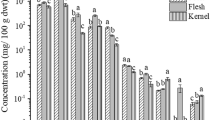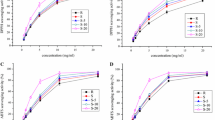Abstract
Raw, skinless peanut kernels from US commercial production lines were dry- and oil-roasted according to standard industrial practices. Eighty percent (v/v) methanolic extracts from the peanut cultivars were prepared and characterized by RP-HPLC: five predominant compounds were found comprising free p-coumaric acid and potential p-coumaric acid derivatives, as elucidated by DAD-UV spectra with comparisons to those of commercial standards. A Spanish high-oleic peanut possessed the greatest naturally-occurring level of p-coumaric acid and its derivatives, followed by a high-oleic Runner, a normal Runner, and a Virginia peanut. Upon thermal processing, p-coumaric acid was liberated at the expense of its derivatives according to the relationship: oil roasting > dry roasting > raw. A high-oleic Runner exhibited the greatest increase (∼785%) in free p-coumaric acid levels after oil roasting. For many of the samples from the 2007 crop, processing increased the TPC and antioxidant capacities in the order of raw < dry roast < oil roast, but results were cultivar dependent. Oil-roasted peanuts were more effective at scavenging O2 ●- than their dry-roasted counterparts, as determined by a photochemiluminescence assay. Overall findings indicate that although thermal processing altered the composition of peanut kernel antioxidants, TPC values and radical-scavenging activities are preserved. Depending on peanut type, cultivar, and harvest date, enhanced antioxidant capacities can result.

Similar content being viewed by others
Abbreviations
- AAPH:
-
2,2′-azobis(2-amidinopropane)dihydrochloride
- ABTS:
-
2,2′-azinobis(3-ethylbenzothiazoline-6-sulphonic acid)
- ABTS●+ :
-
2,2′-azinobis(3-ethylbenzothiazoline-6-sulphonic acid) radical cation
- BHA:
-
butylated hydroxyanisole
- EDTA:
-
ethylenediaminetetraacetic acid
- EP:
-
edible peanut
- EQ:
-
equivalents
- FL:
-
fluorescein (3′6′-dihydroxy-spiro[isobenzofuran-1[3H],9′[9H]-xanthen]-3-one)
- MUFA:
-
monounsaturated fatty acids
- O2 ●- :
-
superoxide radical anion
- ORACFL :
-
oxygen radical absorbance capacity (fluorescein probe)
- PCLACW :
-
Photochem® water soluble antioxidant capacity
- PUFA:
-
polyunsaturated fatty acids
- RO ●2 :
-
peroxyl radical
- TBHQ:
-
tert-butylhydroquinone
- TEAC:
-
Trolox equivalent antioxidant capacity
- TPC:
-
total phenolics content
References
USDA (2009) United States Department of Agriculture-Agricultural Research Service. USDA National Nutrient Database for Standard Reference, Release 22. Nutrients in 100-g raw peanuts (Arachis hypogea), all types. http://www.nal.usda.gov/fnic/foodcomp/search/ (accessed January 23, 2010)
Mercer LC, Wynne JC, Young CT (1990) Inheritance of fatty acid content in peanut oil. Peanut Sci 17:17–21
Braddock JC, Sims CA, O’Keefe SF (1995) Flavor and oxidative stability of roasted high oleic acid peanuts. J Food Sci 60:489–493
Kris-Etherton PM, Yu-Poth S, Sabaté J, Ratcliffe HE, Zhao G, Etherton TD (1999) Nuts and their bioactive constituents: effects on serum lipids and other factors that affect disease risk. Am J Clin Nutr 70:504S–511S
Jiang R, Manson JE, Stampfer MJ, Liu S, Willett WC, Hu FB (2002) Nut and peanut butter consumption and risk of type 2 diabetes in women. JAMA 288:2554–2560
O’Byrne DJ, Knauft DA, Shireman RB (1997) Low fat–monounsaturated rich diets containing high-oleic peanuts improve serum lipoprotein profiles. Lipids 32:687–695
Isanga J, Zhang G-N (2007) Biologically active components and nutraceuticals in peanuts and related products: Review. Food Rev Int 23:123–140
Kris-Etherton PM, Hu FB, Ros E, Sabaté J (2008) The role of tree nuts and peanuts in the prevention of coronary heart disease: Multiple potential mechanisms. J Nutr 138:1746S–1751S
Talcott ST, Passeretti S, Duncan CE, Gorbet DW (2005) Polyphenolic content and sensory properties of normal and high oleic acid peanuts. Food Chem 90:379–388
Pellegrini N, Serafini M, Salvatore S, Del Rio D, Bianchi M, Brighenti F (2006) Total antioxidant capacity of spices, dried fruits, nuts, pulses, cereals and sweets consumed in Italy assessed by three different in vitro assays. Mol Nutr Food Res 50:1030–1038
Talcott ST, Duncan CE, Del Pozo-Insfran D, Gorbet DW (2005) Polyphenolic and antioxidant changes during storage of normal, mid, and high oleic acid peanuts. Food Chem 89:77–84
Duncan CE, Gorbet DW, Talcott ST (2006) Phytochemical content and antioxidant capacity of water-soluble isolates from peanuts (Arachis hypogaea L.). Food Res Int 39:898–904
Rehman Z-U (2003) Evaluation of antioxidant activity of methanolic extract from peanut hulls in fried potato chips. Plant Foods Hum Nutr 58:75–83
Hwang J-Y, Shue Y-S, Chang H-M (2001) Antioxidative activity of roasted and defatted peanut kernels. Food Res Int 34:639–647
Chukwumah Y, Walker L, Vogler B, Verghese M (2007) Changes in the phytochemical composition and profile of raw, boiled, and roasted peanuts. J Agric Food Chem 55:9266–9273
Kotz BA (2009) Vice-President of specialty products. Golden Peanut Company, Alpharetta, GA. Personal Communication.
Amarowicz R, Pegg RB, Rahimi-Moghaddam P, Barl B, Weil JA (2004) Free-radical scavenging capacity and antioxidant activity of selected plant species from the Canadian prairies. Food Chem 84:551–562
Weidner S, Frączek E, Amarowicz R, Abe S (2001) Alterations in phenolic acids content in developing rye grains in normal environment and during enforced dehydration. Acta Physiol Plant 23:475–482
Swain T, Hillis WE (1959) The phenolic constituents of Prunus domestica. I.–The quantitative analysis of phenolic constituents. J Sci Food Agric 10:63–68
Prior RL, Hoang H, Gu L, Wu X, Bacchiocaa M, Howard L, Hampsch-Woodhill M, Huang D, Ou B, Jacob R (2003) Assays for hydrophilic and lipophilic antioxidant capacity (oxygen radical absorbance capacity (ORACFL)) of plasma and other biological and food samples. J Agric Food Chem 51:3273–3279
Pegg RB, Amarowicz R, Naczk M, Shahidi F (2007) PHOTOCHEM® method for determination of antioxidant capacity of plant extracts. In: Shahidi F, Ho C-T (eds) Antioxidant Measurements and Applications. ACS Symposium Series 956, American Chemical Society, Washington, DC, pp 140–158
Re R, Pellegrini N, Proteggente A, Pannala A, Yang M, Rice-Evans C (1999) Antioxidant activity applying an improved ABTS radical cation decolorization assay. Free Rad Biol Med 26:1231–1237
O’Rourke N, Hatcher L, Stepanski EJ (2005) A step-by-step approach to using SAS® for univariate and multivariate statistics, 2nd edn. SAS Institute, Inc, Cary, NC
Bandara BMR, Hewage CM, Karunaratne V, Adikaram NKB (1988) Methyl ester of para-coumaric acid: Antifungal principle of the rhizome of Costus speciosus. Planta Med 54:477–478
Horn BW (2005) Colonization of wounded peanut seeds by soil fungi: selectivity for species from Aspergillus section Flavi. Mycologia 97:202–217
Zieliński H, Michalska A, Piskuła MK, Kozłowska H (2006) Antioxidants in thermally treated buckwheat groats. Mol Nutr Food Res 50:824–832
Xu G, Ye X, Chen J, Liu D (2007) Effect of heat treatment on the phenolic compounds and antioxidant capacity of citrus peel extract. J Agric Food Chem 55:330–335
Chung S-Y, Champagne ET (2009) Reducing the allergenic capacity of peanut extracts and liquid peanut butter by phenolic compounds. Food Chem 115:1345–1349
Rhee KS, Watts BM (1966) Evaluation of lipid oxidation in plant tissues. J Food Sci 31:664–668
USDA-ARS (2007) Oxygen radical absorbance capacity (ORAC) of selected foods—2007. http://www.ars.usda.gov/Services/docs.htm?docid=15866 (accessed January 23, 2010)
Acknowledgments
Financial support for this study was provided by the USDA National Needs Fellowship Program and the Georgia Food Processing Advisory Council (FoodPAC) of Georgia’s Traditional Industries Program for Food Processing. We would also like to acknowledge Robert Karn (Product Development Manager, American Blanching Company, Fitzgerald, GA) and Bruce Kotz (Vice-President of Specialty Products, Golden Peanut Company, Alpharetta, GA) for their insights into peanut processing & production in the US.
Author information
Authors and Affiliations
Corresponding author
Additional information
An erratum to this article can be found at http://dx.doi.org/10.1007/s11130-010-0174-4
Rights and permissions
About this article
Cite this article
Craft, B.D., Kosińska, A., Amarowicz, R. et al. Antioxidant Properties of Extracts Obtained from Raw, Dry-roasted, and Oil-roasted US Peanuts of Commercial Importance. Plant Foods Hum Nutr 65, 311–318 (2010). https://doi.org/10.1007/s11130-010-0160-x
Published:
Issue Date:
DOI: https://doi.org/10.1007/s11130-010-0160-x




